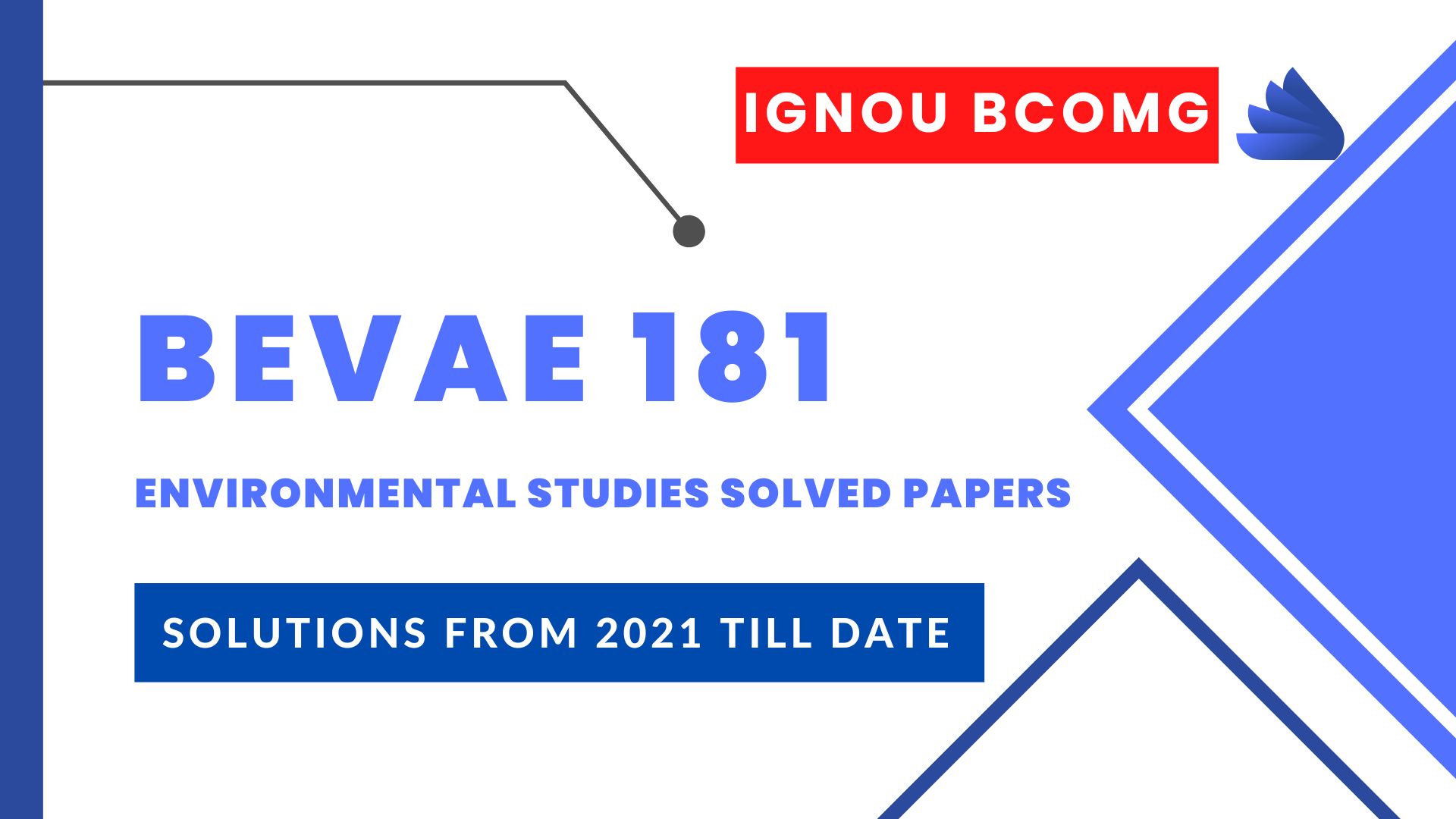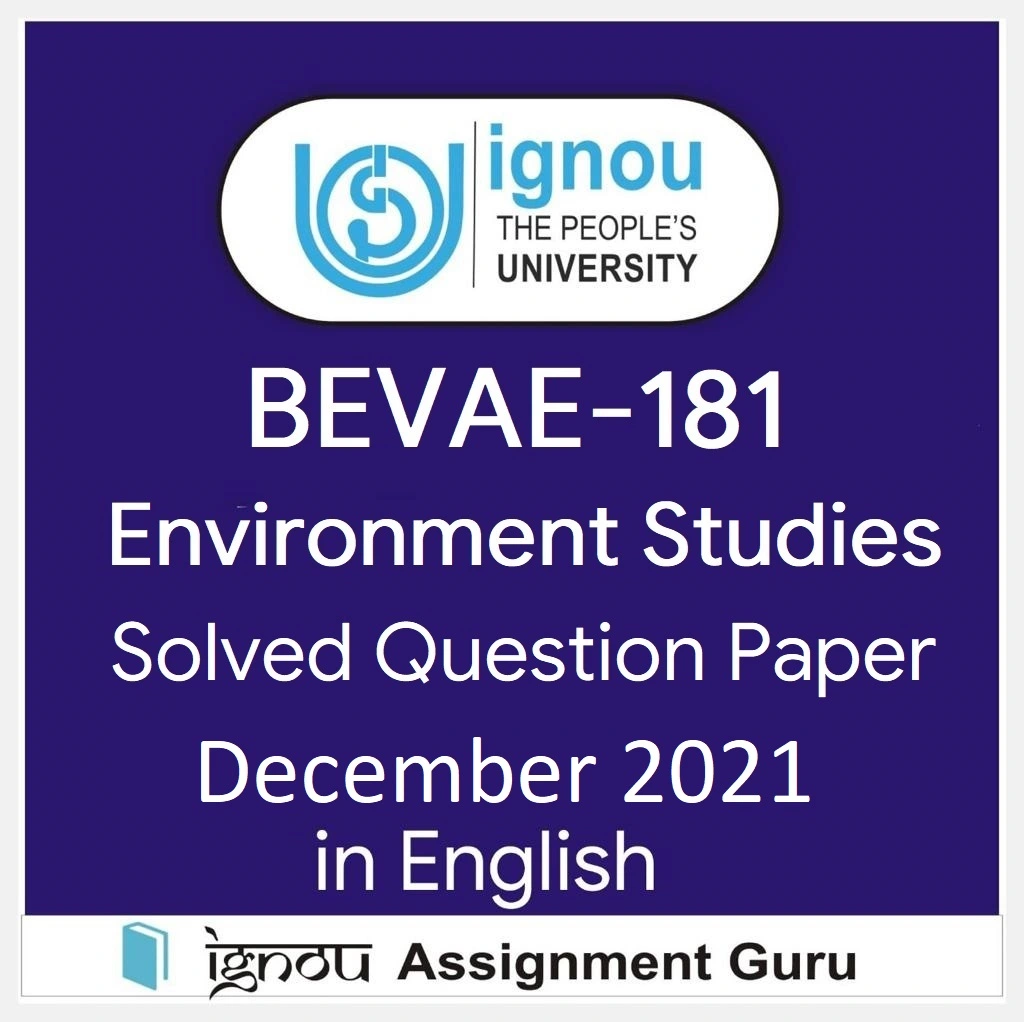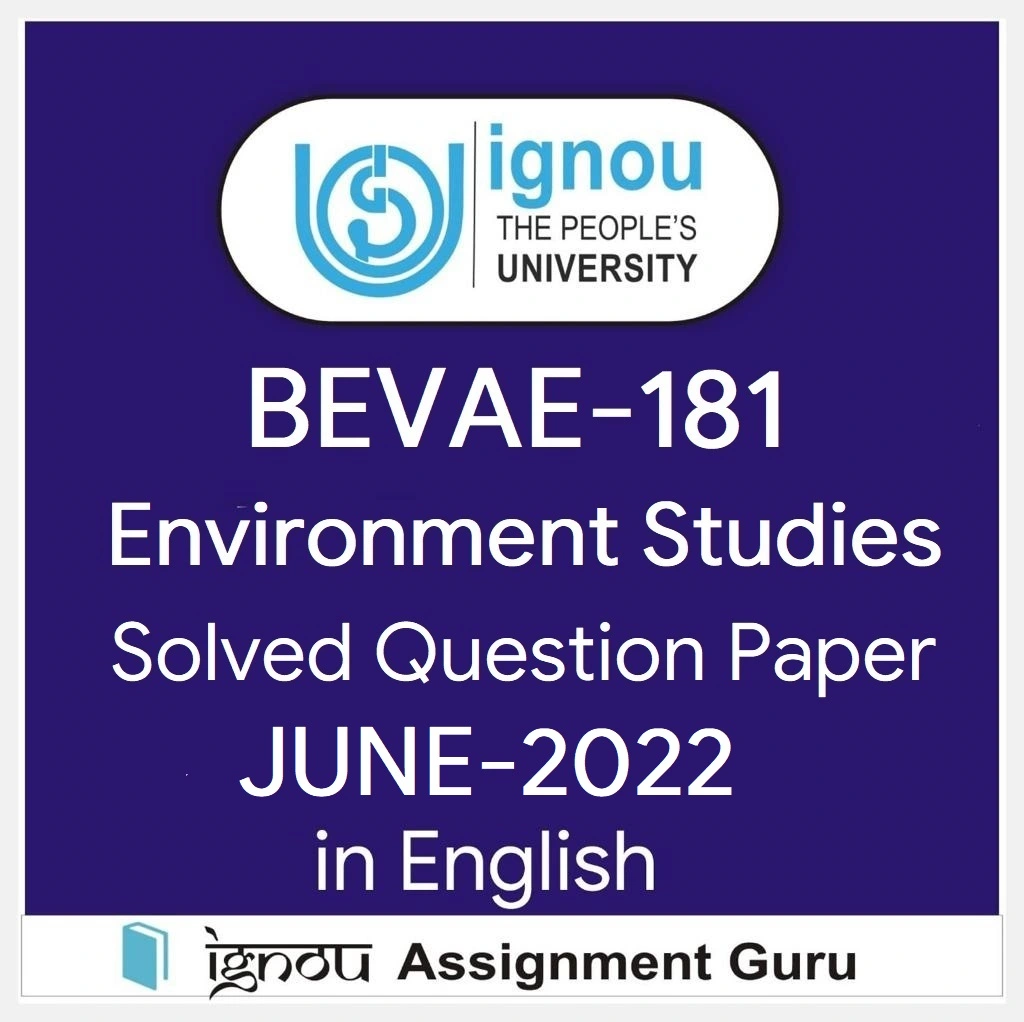

AAECC/BEVAE 181-AECC ON ENVIRONMENTAL STUDIES (IGNOU-BAG) Solved Assignment 2022-2023
- 2 1. Why ecological significance of forest is more important in present day context? Explain.
- 3.1 a) Explain the characteristics of Western Ghats for inclusion as Biodiversity hotspots.
- 3.2 b) Why hydropower is regarded as the best source of energy? Explain it in detail.
- 3.3 c) The importance of Biomass has been increasing day by day in our surroundings among renewable resources. Explain it with suitable examples.
- 3.4 d) How does air pollution affect the atmospheric processes?
- 3.5 e) What is Disposal of waste? Why segregation of waste is needed?
- 4 3. Explain the human-environment relationship by taking examples of biotic and abiotic components?
- 5 4. “As humans civilisation progressed, man started altering the environment in the pursuit of creating an economic, social and cultural environment of his own choice. This slowly resulted in the depletion of natural resources and degradation of environment.” Explain it in context of national legislations of water acts?
- 6 5. “Biosphere reserves are internationally recognised areas established to promote and demonstrate a balanced relationship between Humans and the Biosphere.” Elaborate this statement in the context of conservation of nature?
- 7.1 (a) Seed Bank
- 7.2 (b) Incineration
- 7.3 (c) Biological Oxygen Demand
- 7.4 (d) Public Health
- 9.1 (a) What is lentic and lotic ecosystem? Explain these two with suitable examples.
- 9.2 (b) What is ecological succession? Explain the types of succession with suitable diagrams.
- 9.3 (c) Explain the biocentrism and ecocentrism in context of human’s attitude towards nature?
- 9.4 (d) Define natural calamities and its types with suitable examples.
- 10 8. Explain the causes of ozone depletion? How do ultraviolet rays affects human health, animals, plants, micro-organisms, water and air quality.
- 11 9. “Education for environmental awareness is essential for the younger generation as well as for the older generation.” Explain the statement with suitable examples.
- 12.1 How to Download AAECC/BEVAE 181-AECC ON ENVIRONMENTAL STUDIES Solved Assignment?
- 12.2 Is the AAECC/BEVAE 181-AECC ON ENVIRONMENTAL STUDIES Solved Assignment Free?
- 12.3 What is the last submission date for (IGNOU-BAG) Solved Assignment?

1. Why ecological significance of forest is more important in present day context? Explain.
Answer. Forests play a crucial role in maintaining the delicate balance of the Earth’s ecosystem and are of immense ecological significance. The importance of forests has become even more pronounced in the present day context due to several reasons.
- Biodiversity: Forests are a repository of a wide range of flora and fauna. They provide habitat to millions of species and support their survival. In the present day context, where the rate of extinction of species is alarmingly high, preserving forests is more important than ever.
- Carbon Sequestration: Forests absorb and store large amounts of carbon dioxide from the atmosphere, thus mitigating the effects of climate change. In a world grappling with the impacts of global warming, forests play a critical role in mitigating the effects of climate change.
- Water Cycle: Forests play a crucial role in regulating the water cycle by acting as catchments, storing water, and releasing it gradually. They help prevent soil erosion and reduce the risk of natural disasters such as floods. In the present day context, where water resources are increasingly under threat, forests play an important role in maintaining water security.
- Livelihoods: Forests provide livelihoods to millions of people across the world. They are a source of food, fuel, and income for local communities. In the present day context, where poverty and unemployment are major challenges, forests play an important role in supporting the livelihoods of communities.
- Climate Regulation: Forests play a critical role in regulating the Earth’s climate. They help maintain temperature and rainfall patterns and provide shade, thus reducing the impacts of heatwaves and droughts. In the present day context, where extreme weather events are becoming more frequent, forests play an increasingly important role in regulating the climate.
In conclusion, the ecological significance of forests is more important in the present day context due to the growing threat to biodiversity, the impacts of climate change, the increasing pressure on water resources, the need to support livelihoods, and the importance of regulating the Earth’s climate. It is imperative that steps are taken to protect and preserve forests and their ecosystems.
2. Answer the following questions in about 125 words each.
A) explain the characteristics of western ghats for inclusion as biodiversity hotspots..
Answer. The Western Ghats, a mountain range located in India, is recognized as one of the world’s biodiversity hotspots. The following characteristics contribute to its inclusion as a hotspot:
- High Endemism: The Western Ghats are home to a large number of species that are found nowhere else in the world, making it a unique and valuable ecosystem.
- Rich Diversity: The Western Ghats are rich in biodiversity, with over 5000 species of flowering plants and numerous species of animals, including many threatened and endangered species.
- Threatened Ecosystems: The Western Ghats are under threat from human activities such as deforestation, urbanization, and mining, which have led to the loss of important habitats and ecosystems.
- Unique Geography: The Western Ghats’ unique geography, with its varied altitude, rainfall patterns, and soil types, has created a range of habitats that support a diverse range of species.
- High Endangerment: Many of the species found in the Western Ghats are highly endangered, making it imperative to protect the region to ensure their survival.
In conclusion, the Western Ghats’ high levels of endemism, rich biodiversity, threatened ecosystems, unique geography, and high levels of endangerment make it an important biodiversity hotspot that deserves protection and preservation.
b) Why hydropower is regarded as the best source of energy? Explain it in detail.
Answer. Hydropower is regarded as one of the best sources of energy for several reasons:
- Renewable: Hydropower is a renewable energy source, as it relies on the natural flow of water, making it a sustainable source of energy.
- Efficient: Hydropower is an efficient energy source, as it can generate large amounts of energy from a single power plant. It is also capable of generating energy consistently and on a large scale, making it an attractive energy source.
- Clean: Hydropower is a clean source of energy, as it does not emit harmful pollutants or greenhouse gases, making it an environmentally friendly source of energy.
- Stable: Hydropower is a stable energy source, as it can be relied upon to generate energy consistently, making it a reliable source of energy.
- Cost-effective: Hydropower is a cost-effective energy source, as it requires a relatively low investment in infrastructure and has low operating costs, making it an attractive energy source.
In conclusion, hydropower’s characteristics as a renewable, efficient, clean, stable, and cost-effective source of energy make it one of the best sources of energy. These qualities make it an attractive alternative to traditional sources of energy, such as fossil fuels, which are finite and emit harmful pollutants.
c) The importance of Biomass has been increasing day by day in our surroundings among renewable resources. Explain it with suitable examples.
Answer. Biomass is a renewable energy source that has been gaining importance in recent times. This is due to several reasons:
- Abundance: Biomass is abundant, as it can be sourced from a wide range of organic materials such as wood, crops, and waste, making it a widely available energy source.
- Renewable: Biomass is a renewable energy source, as it is replenished through the growth of new crops and the processing of waste.
- Clean: Biomass is a clean source of energy, as it emits less carbon dioxide compared to fossil fuels, and its emissions are absorbed through the growth of new crops.
- Localized: Biomass energy can be produced locally, reducing the need for long-distance transportation and reducing the risk of supply chain disruptions.
- Versatile: Biomass can be used for a variety of energy applications, including electricity generation, heating, and transportation.
Examples of the increasing importance of biomass include the widespread adoption of biomass-based electricity generation in rural areas, the use of biomass for heating homes and businesses, and the use of biofuels for transportation.
In conclusion, the increasing importance of biomass is due to its abundance, renewability, cleanliness, localization, and versatility. These characteristics make it an attractive alternative to traditional sources of energy, such as fossil fuels, and a crucial part of the transition to a low-carbon energy future.
d) How does air pollution affect the atmospheric processes?
Answer. Air pollution has a significant impact on the atmospheric processes, altering the natural balance of the atmosphere and affecting the quality of air we breathe. Excessive levels of air pollutants such as sulfur dioxide, nitrogen oxides, and particulate matter can interfere with the atmospheric processes, including the formation of clouds and precipitation, as well as the transportation of heat and moisture. This can lead to changes in atmospheric circulation patterns, leading to changes in local weather patterns and potentially causing longer term climate change. In addition, air pollutants can also have a direct impact on human health by causing respiratory and cardiovascular diseases, as well as contributing to the formation of acid rain, which can harm the ecosystem and wildlife. By reducing the quality of air, air pollution also affects the atmospheric visibility and the natural beauty of the sky, making it harder for us to appreciate the wonders of nature.
e) What is Disposal of waste? Why segregation of waste is needed?
Answer. Disposal of waste refers to the management of waste materials after they are produced. It includes the collection, transportation, processing, and disposal of waste materials in a way that minimizes harm to the environment and public health. Segregation of waste is necessary because different types of waste have different disposal requirements. For example, organic waste can be composted, while electronic waste must be recycled or disposed of properly to prevent the release of toxic chemicals. Segregating waste also makes it easier and more efficient to process, as different types of waste can be treated and disposed of in a way that is appropriate for each specific material. Segregation also helps to reduce the overall volume of waste and promote the recycling of materials, conserving natural resources and reducing greenhouse gas emissions.
3. Explain the human-environment relationship by taking examples of biotic and abiotic components?
Ans: The human-environment relationship refers to the interdependence between humans and their natural surroundings. Biotic components, such as plants and animals, form the living part of the environment, while abiotic components, such as air, water, and soil, form the non-living part. For example, humans rely on biotic components for food, medicine, and materials, and in turn, human activities such as agriculture, forestry, and urbanization can impact the population and distribution of biotic components. On the other hand, abiotic components, such as air and water, play a crucial role in regulating the Earth’s climate and supporting life. Human activities, such as industrial processes and transportation, can increase the levels of air pollutants, affecting air quality and contributing to climate change. It is important to recognize and understand the interdependence between humans and their environment in order to sustainably manage and protect the Earth’s resources for future generations.
4. “As humans civilisation progressed, man started altering the environment in the pursuit of creating an economic, social and cultural environment of his own choice. This slowly resulted in the depletion of natural resources and degradation of environment.” Explain it in context of national legislations of water acts?
Ans: As human civilization progressed, the pursuit of economic, social and cultural development has led to significant alterations in the natural environment. This has resulted in the depletion of natural resources, including water, and the degradation of the environment. In order to address this issue, national legislations have been enacted to regulate the use and management of water resources.
One such legislation is the National Water Act of India, which was enacted in 1974 with the aim of promoting the integrated development and management of water resources in the country. The act recognizes the need for conservation and augmentation of water resources, as well as the equitable distribution of water for different uses. It also outlines the responsibilities of different stakeholders, including the central and state governments, and water user associations, in the management of water resources.
Similarly, the National Water Policy of India was formulated in 1987 with the objective of providing a comprehensive framework for the development and management of water resources in the country. The policy emphasizes the need for conservation and efficient use of water resources, as well as the protection of water quality and the promotion of sustainable water use practices.
In addition to these national legislations, there are also state-level water acts and policies, such as the Maharashtra Water Resources Regulatory Authority Act of 2005, which aim to promote the sustainable development and management of water resources in specific states.
Despite the presence of these legislations, the depletion of water resources and degradation of water quality continues to be a major challenge in many parts of the country. This highlights the need for effective implementation and enforcement of these laws, as well as the need for increased public awareness and engagement in the sustainable use and management of water resources.
In conclusion, the alteration of the natural environment in the pursuit of economic, social and cultural development has led to significant challenges in the management of water resources. National and state-level legislations play a crucial role in addressing these challenges, but effective implementation and enforcement, as well as increased public engagement, are also essential for promoting sustainable water use and management.
5. “Biosphere reserves are internationally recognised areas established to promote and demonstrate a balanced relationship between Humans and the Biosphere.” Elaborate this statement in the context of conservation of nature?
Ans: Biosphere reserves are internationally recognized areas established to promote and demonstrate a balanced relationship between humans and the biosphere. These reserves are established to conserve and manage the rich biological diversity of our planet, as well as to promote sustainable use of natural resources. They are recognized as important tools for nature conservation and sustainable development, and play a crucial role in the conservation of nature.
Biosphere reserves are designated by the United Nations Educational, Scientific and Cultural Organization (UNESCO) under its Man and the Biosphere (MAB) program. The program was established in 1971 with the aim of promoting interdisciplinary approaches to the study of the relationship between humans and the environment. Biosphere reserves are established in different regions of the world, and are characterized by their unique combinations of biotic and abiotic components, including forests, wetlands, deserts, grasslands, and coastal and marine ecosystems.
The main objectives of biosphere reserves include the conservation of biodiversity, the promotion of sustainable use of natural resources, and the development of scientific and educational programs to support sustainable development. In order to achieve these objectives, biosphere reserves employ a multi-disciplinary approach, bringing together experts from a wide range of fields, including ecology, sociology, economics, and education.
Biosphere reserves also play an important role in the conservation of endangered species and the protection of threatened ecosystems. By conserving large areas of natural habitat, biosphere reserves help to ensure that biodiversity is maintained for future generations. Additionally, biosphere reserves promote the sustainable use of natural resources, such as water, forests, and fisheries, helping to ensure that these resources are used in a way that is both economically viable and environmentally sustainable.
Moreover, biosphere reserves serve as important educational and research centers, providing opportunities for students, researchers, and the general public to learn about the interdependence between humans and the environment, and the importance of conservation and sustainable use of natural resources. By promoting scientific research, education, and public awareness, biosphere reserves help to build the capacity of local communities to manage their natural resources in a sustainable manner.
In conclusion, biosphere reserves are important tools for the conservation of nature and the promotion of sustainable development. By conserving biodiversity, promoting sustainable use of natural resources, and providing opportunities for education and research, biosphere reserves play a crucial role in balancing the relationship between humans and the biosphere, and in ensuring that our planet remains rich and diverse for future generations.
6. Explain the following terms in about 60 words each:
(a) seed bank.
Ans: A seed bank is a collection of seeds from different plant species, stored for the purpose of conservation and preservation. The seeds are stored in controlled conditions, such as temperature and humidity, to ensure their viability for future use. Seed banks play an important role in the conservation of plant diversity and in the protection of genetic resources. They provide a source of seed for research, breeding, and restoration programs, as well as for future food security.
(b) Incineration
Ans: Incineration is the process of burning waste at high temperatures to convert it into ash, gases, and heat. It is a method of waste treatment and disposal, used primarily for medical and hazardous waste, as well as for the disposal of solid waste in some countries. Incineration is a controversial method due to the release of air pollutants and the generation of hazardous ash, but proponents argue that it is a necessary solution for managing certain types of waste. The efficiency and environmental impact of incineration vary greatly depending on the type of waste and the technology used.
(c) Biological Oxygen Demand
Ans: Biological Oxygen Demand (BOD) is a measure of the amount of oxygen consumed by microorganisms in the process of breaking down organic matter in water. It is a widely used indicator of the quality of water, particularly in rivers and lakes. BOD is expressed in milligrams of oxygen per liter of water (mg/L) and represents the oxygen requirement of bacteria and other microorganisms in the water over a set period of time, typically 5 days. High BOD levels can indicate the presence of organic pollution in water, which can lead to the depletion of oxygen, causing harm to aquatic life and reducing water quality. Low BOD levels indicate good water quality.
(d) Public Health
Ans: Public health refers to the study and practice of improving the health of populations, through the prevention and control of diseases, injury and other health problems. It is a broad field that encompasses a range of activities and initiatives aimed at promoting health and preventing disease, such as health education, disease surveillance, research, and community-based interventions. Public health professionals work to improve the health of individuals, families, and communities by addressing the underlying social and environmental determinants of health. The goal of public health is to improve the health of populations, reduce health disparities, and promote health equity.
7. Answer the following questions in about 150 words each.
(a) what is lentic and lotic ecosystem explain these two with suitable examples..
Ans: Lentic and lotic ecosystems refer to the two types of freshwater ecosystems based on the movement of water. Lentic ecosystems are still or standing water bodies, such as ponds, lakes, and wetlands. They are characterized by slow or no water movement and the presence of various species of plants and animals adapted to the still water conditions. Examples of lentic ecosystems include a pond in a park, a lake in a mountain region, and a wetland in a coastal area.
Lotic ecosystems are moving water bodies, such as rivers and streams. They are characterized by fast-flowing water, high oxygen levels, and the presence of species adapted to the dynamic water conditions. Examples of lotic ecosystems include a fast-flowing river in a tropical region, a stream in a forest, and a rapids in a mountainous area.
Both lentic and lotic ecosystems play important roles in the ecosystem, providing habitats for numerous species, regulating water flow and quality, and supporting many ecosystem services. However, due to human activities such as pollution, dam construction, and land use changes, these ecosystems are under threat and their conservation is crucial for maintaining the health and integrity of freshwater ecosystems.
(b) What is ecological succession? Explain the types of succession with suitable diagrams.
Ans: Ecological succession is the gradual process of change in the species composition and structure of an ecosystem over time. It occurs in response to natural disturbances, such as fires, floods, or landslides, or in newly created habitats, such as a newly formed island or a newly disturbed area. The process of succession results in the development of a stable and self-sustaining ecosystem, known as a climax community.
There are two types of ecological succession: primary and secondary. Primary succession occurs in newly formed habitats with no pre-existing soil, such as a volcanic island or a newly formed sand dune. In primary succession, the first colonizing species are typically pioneer species that can tolerate harsh conditions, such as lichens and mosses. Over time, other species with greater requirements for water, nutrients, and light establish, resulting in the development of a diverse and stable community.
Secondary succession occurs in disturbed habitats where the soil and some vegetation remain intact, such as after a fire or a timber harvest. In secondary succession, the process of species replacement is faster and occurs within the context of an existing soil and vegetation. The first colonizing species in secondary succession are typically opportunistic species that can quickly establish, such as annual grasses and pioneer trees. Over time, the community structure and species composition change, resulting in the development of a diverse and stable ecosystem.
In both types of succession, the process of community development is characterized by changes in species composition, structure, and ecosystem processes. These changes lead to the development of a more complex and diverse community, which eventually reaches a state of stability known as the climax community.
(c) Explain the biocentrism and ecocentrism in context of human’s attitude towards nature?
Ans: Biocentrism and ecocentrism are two different perspectives that describe the relationship between humans and the natural environment. Biocentrism is an ethical viewpoint that considers all living beings, including humans, as equal in moral value and deserving of equal consideration. It recognizes that all species have inherent value and that their well-being and survival are important in their own right. This perspective places the needs and interests of individual species at the center of ethical considerations and considers the impact of human actions on other species and ecosystems.
Ecocentrism, on the other hand, considers the Earth as a holistic and interconnected system, with each part affecting the other. This perspective recognizes that the well-being and survival of the entire Earth system, including humans, is interdependent and that all species and ecosystems are essential components of the system. It considers the impact of human actions on the entire Earth system and seeks to balance human needs with the needs of the environment.
Both biocentrism and ecocentrism are important perspectives for understanding the human-nature relationship. Biocentrism provides a moral framework for protecting individual species and ecosystems, while ecocentrism provides a holistic framework for considering the impact of human actions on the entire Earth system. In practical terms, ecocentrism is often translated into environmental policies that aim to protect and restore the health of the Earth system, while biocentrism is often translated into conservation policies that aim to protect and preserve individual species and ecosystems.
(d) Define natural calamities and its types with suitable examples.
Ans: Natural calamities are catastrophic events that occur in the natural environment, causing widespread damage and loss of life. They are caused by natural phenomena, such as earthquakes, hurricanes, floods, droughts, and wildfires, and can have a significant impact on human populations and the environment. Natural calamities are often unpredictable and can result in major disruptions to communities and economies.
There are several types of natural calamities, including:
- Geological disasters – earthquakes, volcanic eruptions, and tsunamis. An example is the 2004 Indian Ocean earthquake and tsunami that resulted in widespread destruction and loss of life in several countries.
- Hydrological disasters – floods, droughts, and landslides. An example is the 2008 Sichuan earthquake in China that triggered widespread landslides and caused significant damage to the region.
- Meteorological disasters – hurricanes, typhoons, and tornadoes. An example is Hurricane Katrina that struck the Gulf Coast of the United States in 2005, causing widespread damage and loss of life.
- Wildfires – uncontrolled fires that spread rapidly and cause damage to natural areas and communities. An example is the 2019-2020 bushfires in Australia that resulted in widespread damage and loss of life.
It is important to prepare for natural calamities by implementing disaster risk reduction strategies, such as early warning systems, evacuation plans, and infrastructure improvements. This can help to minimize the impact of natural calamities on communities and reduce the loss of life and property.
8. Explain the causes of ozone depletion? How do ultraviolet rays affects human health, animals, plants, micro-organisms, water and air quality.
Ans: Ozone depletion is the thinning of the ozone layer, a region in the Earth’s stratosphere that protects life on Earth from harmful ultraviolet (UV) rays. This depletion is caused by the release of certain chemicals, primarily chlorofluorocarbons (CFCs), into the atmosphere. These chemicals rise into the stratosphere and break down the ozone molecules, leading to a decline in the ozone layer’s thickness.
The increase in UV radiation reaching the Earth’s surface as a result of ozone depletion has several negative impacts on human health, animals, plants, micro-organisms, water, and air quality.
- Human health: Increased UV radiation can cause skin cancer, cataracts, and weaken the immune system.
- Animals: Increased UV radiation can cause harm to marine organisms, such as phytoplankton, and can negatively impact their populations, causing a ripple effect throughout the food chain.
- Plants: Increased UV radiation can cause damage to plant DNA, reduce crop yields, and disrupt the growth and reproduction of forest trees.
- Micro-organisms: Increased UV radiation can harm phytoplankton, which is a crucial component of the food chain, and can also reduce the populations of beneficial bacteria.
- Water quality: Increased UV radiation can affect the quality of water by breaking down pollutants, creating harmful by-products, and reducing the population of beneficial microorganisms.
- Air quality: Increased UV radiation can affect air quality by breaking down air pollutants and creating harmful by-products.
It is important to reduce the release of ozone-depleting chemicals into the atmosphere and promote the use of alternative, ozone-friendly products. This can help to slow down the process of ozone depletion and reduce the negative impact of increased UV radiation on human health and the environment.
9. “Education for environmental awareness is essential for the younger generation as well as for the older generation.” Explain the statement with suitable examples.
Ans: Education for environmental awareness is crucial in fostering a responsible and sustainable relationship between humans and the natural world. It involves educating individuals of all ages about the importance of preserving the environment and the impact of human activities on the environment.
- Younger Generation: Children and young people are the future stewards of the environment and it is crucial to educate them about the importance of preserving the natural world. By teaching them about the consequences of environmental degradation and how they can contribute to a more sustainable future, they can develop environmentally conscious behaviors and habits that will last a lifetime.
- Older Generation: Older people have a wealth of knowledge and experience that can contribute to environmental awareness and conservation. By educating them about environmental issues and the role they can play in mitigating environmental degradation, they can help to spread environmental awareness to other members of their communities.
Examples of environmental education include school-based environmental programs, community environmental initiatives, and environmental awareness campaigns. These initiatives can help to build environmental awareness, educate individuals about the importance of preserving the environment, and promote sustainable behaviors.
In conclusion, environmental education is essential for individuals of all ages and backgrounds. By raising awareness and promoting responsible behaviors, we can help to protect the environment and ensure a sustainable future for generations to come.
10. “Water Harvesting is one of the effective measures to combat drought.” Explain this statement with suitable arguments.
Water harvesting refers to the collection, storage, and distribution of rainwater in an effort to conserve and manage water resources. With the increasing frequency of droughts in many regions, water harvesting has become a critical measure to combat these dry spells and ensure a stable water supply.
One of the main arguments in favor of water harvesting is its ability to mitigate the effects of drought. By storing rainwater, communities can continue to access water even during prolonged dry periods. This helps to maintain food production, sustain livestock, and support basic needs such as hygiene and sanitation.
Another benefit of water harvesting is its potential to reduce pressure on existing water resources. With increasing demand for water, many traditional sources such as rivers and groundwater wells are being depleted. Water harvesting allows communities to tap into a different source of water and preserve these other resources for other uses.
In addition to being an effective measure to combat drought, water harvesting also has a number of environmental benefits. It helps to recharge groundwater, reduce soil erosion, and improve soil fertility by providing plants with the water they need to grow.
However, it is important to note that water harvesting is not a panacea for drought. In order to be effective, it must be implemented in conjunction with other measures such as water conservation and efficient irrigation practices.
In conclusion, water harvesting is one of the effective measures to combat drought as it allows communities to store and access water during dry periods, reduces pressure on existing water resources, and has a number of environmental benefits. It is important to implement it as part of a broader strategy to manage and conserve water resources.
How to Download AAECC/BEVAE 181-AECC ON ENVIRONMENTAL STUDIES Solved Assignment?
You can download it from the www.edukar.in , they have a big database for all the IGNOU solved assignments.
Is the AAECC/BEVAE 181-AECC ON ENVIRONMENTAL STUDIES Solved Assignment Free?
Yes this is absolutely free to download the solved assignment from www.edukar.in
What is the last submission date for (IGNOU-BAG) Solved Assignment?
For June Examination: 31st March, For December Examination: 30th September
Related Posts:

Leave a Comment Cancel reply
Save my name, email, and website in this browser for the next time I comment.


For IGNOU Courses
BEVAE 181 Solved Question Paper December 2022
BEVAE 181 SOLVED QUESTION PAPER
This article provides a comprehensive and fully solved question paper for the BEVAE-181 Environmental Studies course, which is an essential component of the Ability Enhancement Compulsory Course for students pursuing Bachelor of Arts in General (BAG) and Bachelor of Arts in Vocational Studies specializing in Micro, Small, and Medium Enterprises (BAVMSME) programs. This resource is particularly valuable for students preparing for the upcoming Term-End Examination conducted by the Indira Gandhi National Open University (IGNOU).
Major Instructions to Write BEVAE 181 ENVIRONMENTAL STUDIES
Instructions:
- This is an objective-type question paper.
- You must mark your answers only in the OMR sheet.
- Answer all the questions.
- There are 50 questions, each worth one mark.
- Each question has four alternatives, one of which is correct. Write the Serial Number of your correct answer below the corresponding question number in the OMR sheet and then mark the rectangle for the same number in that column. If none of the given alternatives is correct, write 0 and mark in column 0.
- Do not spend excessive time reading the entire question paper. Progress through the questions one by one. You can return to unanswered questions if time allows.

BEVAE 181 December 2022 solved question Paper
Here are the questions, answer options, and correct answers in four columns, as requested:
englishpot001
Dec 2022 BEVAE 181 Environmental Studies Solved Paper [IGNOU BCOMG]
Ignou bcomg solved question papers.
Term-End Examination, Dec, 2022
Maximum Marks: 50
Time: 2 hours
In this post you will get Dec 2022 BEVAE 181 Environmental Studies Solved Paper . This is a Common paper for the Students of IGNOU BCOMG Pursuing Graduation.

1. Who developed the concept of determinism?
(1) Friedrich Ratzel.
(2) Ellsworth Huntington.
(3) Charles Darwin.
(4) Alexander von Humboldt.
Ans: (1) Friedrich Ratzel.
2. Which of the following is not one of the seventeen Sustainable Development Goals?
(1) Climate Action.
(2) Quality Education.
(3) Gender Equity.
(4) Reducing Inequality.
Ans: (4) Reducing Inequality.
3. Which one of the following is a human modified environment?
(1) Artificial lake.
(2) Sanctuaries.
(3) Crop fields.
Ans: (4) Dams.
4. Which one of the following refers to a position in the food chain?
(1) Community level.
(2) Population level.
(3) Trophic level.
(4) Biotic community.
Ans: (3) Trophic level.
5. In the biosphere water component is known as:
(1) Ecosphere.
(2) Atmosphere.
(3) Lithosphere.
(4) Hydrosphere.
Ans: (4) Hydrosphere.
6. Sulphur cycle is an example of:
(1) gaseous cycle.
(2) sedimentary cycle.
(3) both gaseous and sedimentary cycle.
(4) None of the above.
Ans: (3) both gaseous and sedimentary cycle.
7. Secondary consumers are:
(1) plants.
(2) herbivores.
(3) carnivores.
(4) both herbivores and carnivores.
Ans: (3) carnivores.
8. In coniferous forest the soil is:
(1) acidic and mineral deficient.
(2) very rich in mineral nutrients.
(3) basic and mineral deficient.
(4) moderately basic and rich in mineral nutrients.
Ans: (1) acidic and mineral deficient.
9. Chameleons, agamid and geckos are found in:
(1) temperate rainforest.
(2) tropical seasonal forest.
(3) sub-tropical rainforest.
(4) tropical rainforest.
Ans: (4) tropical rainforest.
10. Which one of the following species excretes very concentrated urine and does not use water for temperature regulation and can live in the desert without drinking water?
(2) Nocturnal rodent.
(3) Ostrich.
(4) Rat-tailed bat.
Ans: (1) Camel.
IGNOU BCOMG Solved Question Papers – BEVAE 181 Environmental Studies
– BEVAE 181 Environmental Studies Solved Question Paper Feb 2021
– BEVAE 181 Environmental Studies Solved Question Paper Dec 2021
– BEVAE 181 Environmental Studies Solved Question Paper June 2022
– BEVAE 181 Environmental Studies Solved Question Paper Dec 2022
11. Unattached aquatic organism which lives at the air-water interface is known as:
(1) Periphyton.
(2) Plankton.
(3) Neuston.
(4) Nekton.
Ans: (3) Neuston.
12. What is the percentage of fresh water where global distribution of water resources is considered?
(1) Less than 3%.
(2) Less than 4%.
(3) Less than 5%.
(4) Less than 6%.
Ans: (1) Less than 3%.
13. Which one of the following is a non-renewable resource?
(1) Wildlife.
(3) Mineral deposits.
(4) Forest.
Ans: (3) Mineral deposits.
14. The average salinity of sea water is:
(2) 3 . 5%.
(3) 4 . 5%.
Ans: (2) 3 . 5%.
15. Which of the following is not achieved by addition of manure?
(1) A more stable aggregate structure.
(2) Improved cohesiveness of soil.
(3) Increase in water retentive capacity.
(4) Decrease in soil salinity.
Ans: (4) Decrease in soil salinity.
16. Which one of the following is not a part of supporting ecological systems and processes function of forest?
(1) Checks the soil erosion.
(2) Improves the air quality.
(3) Reduces the intensity of cyclones and floods.
(4) Acts as a carbon sink.
Ans: (3) Reduces the intensity of cyclones and floods.
17. Which one of the following is a consequence of deforestation?
(1) Increase in soil erosion due to reduction in vegetation.
(2) Increase in the oxygen liberated by plants.
(3) Decrease in carbon dioxide level.
(4) Increase in availability of forest product.
Ans: (1) Increase in soil erosion due to reduction in vegetation.
18. Which one of the following is not a Non-Timber Forest Product (NTFP)?
(1) Medicinal herbs.
(2) Edible leaves and flowers.
(3) Firewood.
(4) Edible fruits.
Ans: (3) Firewood.
19. Which one of the following statements about the biodiversity in India is correct?
(1) The desert areas of Gujarat and Rajasthan have a very high level of desert animal species as well as numerous rare species.
(2) Large scale planting of Bt cotton has no adverse effect on biodiversity.
(3) Western Ghats have a very high degree of species richness and endemism.
(4) Conversion of biodiversity is just a fad push.
Ans: (3) Western Ghats have a very high degree of species richness and endemism.
20. An ecosystem with higher diversity will be:
(1) more complex, stable and resistant.
(2) more fragile and sensitive.
(3) more simple and less stable.
(4) less productive.
Ans: (1) more complex, stable and resistant.
21. Which of the following animals are exclusively found in Brahmaputra Valley?
(1) Chinkara.
(2) Rhinoceros.
(3) Lion-tailed Macaque.
(4) Houbara Bustard.
Ans: (2) Rhinoceros.
22. Which of the following is not a biodiversity hotspot?
(1) The Western Ghats.
(2) The Himalayas.
(3) The Nicobar Group of Islands.
(4) Vindhyas and Satpura region of Madhya Pradesh.
Ans: (4) Vindhyas and Satpura region of Madhya Pradesh.
23. What percentage of energy needs of India are met by the natural gas?
(1) About 7%.
(2) About 8%.
(3) About 6%.
(4) About 5%.
Ans: (4) About 5%.
24. Sludge gas largely consists of:
(1) carbon dioxide.
(2) sulphur dioxide.
(3) methane.
(4) hydrogen sulphide.
Ans: (3) methane.
25. Which one of the following is not a non-conventional source of energy?
(1) Fossil fuel.
(2) Solar energy.
(3) Biomass energy.
(4) Wind energy.
Ans: (1) Fossil fuel.
26. Which of the following is not an adverse effect of the construction of major dams in India?
(1) Submergence of forests and agricultural fields.
(2) Destruction of wildlife habitats.
(3) Displacement of people.
(4) Increase in the groundwater level of the surrounding region.
Ans: (4) Increase in the groundwater level of the surrounding region.
27. Fostering is a useful technique for conservation which has been found successful in:
(1) Whooping crane.
(2) Black-footed ferret.
(3) Angus cow.
(4) Seed plants.
Ans: (1) Whooping crane. (2) Black-footed ferret.
28. Mangroves in the coastal areas work against erosion by acting as:
(1) methane filters.
(2) regulation of water regime.
(3) natural bulwark.
(4) natural recharging aquifers.
Ans: (3) natural bulwark.
29. Which of the following is not an invasive species in India?
(1) Water hyacinth.
(2) Congress grass.
(3) Prosopis juliflora.
(4) Neem tree.
Ans: (4) Neem tree.
30. Buffer zone plays a significant role in the preserved areas. Which one of the following is not an important function of the buffer zone?
(1) It provides jobs and income without any ill-effect on species.
(2) It provides transition into the unmodified natural habitat in the core.
(3) It permits for moderate recreational forestry.
(4) Hunting is permitted in this zone.
Ans: (4) Hunting is permitted in this zone.
31. The size of Respirable Suspended Particulate Matter (RSPM) is:
(1) 1 – 10 mm.
(2) 10 – 20 mm.
(3) 1 – 20 μ m.
(4) 10 – 20 μ m.
Ans: (3) 1 – 20 μ m.
32. _______ is the phenomenon of increase in the concentration of pollutants from one link in a food chain to another.
(1) Biological concentration.
(2) Biomagnification.
(3) Bioconcentration.
(4) Biodegradation.
Ans: (2) Biomagnification.
33. Which one the following is a primary pollutant?
(1) Peroxy Acetyl Nitrate (PAN).
(2) Nitric acid.
(3) Carbon dioxide.
(4) Sulphuric acid.
Ans: (3) Carbon dioxide.
34. High level of BOD indicates:
(1) decreasing levels of organic waste in water.
(2) decreasing levels of sewage in water.
(3) increasing levels of dissolved oxygen in water.
(4) decreasing levels of dissolved oxygen in water.
Ans: (4) decreasing levels of dissolved oxygen in water.
35. Underground disposal is preferred for the disposal of:
(1) domestic wastes.
(2) radioactive nuclear wastes.
(3) plastic wastes.
(4) building debris.
Ans: (2) radioactive nuclear wastes.
36. Read the below given statements about the single-use plastics and choose the correct options.
(i) They clog drains.
(ii) They harm animals.
(iii) They cause floods in cities.
(iv) They can degrade easily.
(1) (i) and (ii) are correct.
(2) (i), (ii) and (iv) are correct.
(3) (i), (ii) and (iii) are correct.
(4) All options are correct.
Ans: (1) (i) and (ii) are correct.
37. Eutrophication in water bodies is caused by:
(1) phosphates and nitrates.
(2) sulphate and nitrates.
(3) carbonates and nitrates.
(4) phosphates and oxalates.
Ans: (1) phosphates and nitrates.
38. Which of the following is not true for Chlorofluorocarbons (CFCs)?
(1) They are responsible for ozone depletion.
(2) They are used in paints and deodorants.
(3) They are stable and remain in lower regions of atmosphere for many years.
(4) They are unaffected by UV radiation in upper atmosphere.
Ans: (2) They are used in paints and deodorants.
39. Which one of the following is used to measure the concentration of ozone?
(1) Parts per kilometer.
(2) Nanometer.
(3) Dobson.
(4) Radium.
Ans: (3) Dobson.
40. What is the approximate percentage of solar radiation which is absorbed by the atmospheric gases?
Ans: (3) 30%.
41. The provision for environmental protection in our Constitution was made in the year:
Ans: (1) 1976.
42. When was the Wildlife Protection Act enacted?
Ans: (4) 1972.
43. Which one of the following is not one of seventeen categories of polluting industries identified by the Central Pollution Control Board?
(1) Pulp and paper.
(2) Oil refineries.
(3) Food processing.
(4) Tanneries.
Ans: (3) Food processing.
44. Projected world population by 2100 would be:
(1) 11 . 2 billion.
(2) 10 . 2 billion.
(3) 12 . 2 billion.
(4) 13 . 2 billion.
Ans: (2) 10 . 2 billion.
45. Match the following:
(1) (a)-(i), (b)-(ii), (c)-(iii), (d)-(iv).
(2) (a)-(ii), (b)-(iv), (c)-(i), (d)-(iii).
(3) (a)-(iii), (b)-(iv), (c)-(ii), (d)-(i).
(4) (a)-(iv), (b)-(iii), (c)-(ii), (d)-(i).
Ans: (2) (a)-(ii), (b)-(iv), (c)-(i), (d)-(iii).
46. Which one of the following areas in India does not fall under seismic zone?
(1) Kachchh region of Gujarat.
(2) Chamoli and Pithoragarh in Uttarakhand.
(4) Bundelkhand region of Uttar Pradesh and Madhya Pradesh.
Ans: (4) Bundelkhand region of Uttar Pradesh and Madhya Pradesh.
47. Chandi Prasad Bhatt was associated with:
(1) Silent Valley Movement.
(2) Green Revolution.
(3) Chipko Movement.
(4) Appiko Movement.
Ans: (3) Chipko Movement.
48. The teaching that all living organisms have values and rights regardless of whether they are useful or not refers to:
(1) Biocentrism.
(2) Stewardship.
(3) Anthropocentrism.
(4) The Western viewpoint.
Ans: (1) Biocentrism.
49. Using English only material for communication to non-English speaking communities is an example of:
(1) social inequity.
(2) geographical inequity.
(3) procedural inequity.
(4) economic inequity.
Ans: (1) social inequity.
50. Which one of the following is not an ENVIS Centre?
(1) National Institute of Occupational Health (NIOH), Ahmedabad.
(2) Central Pollution Control Board, New Delhi.
(3) Tata Institute of Fundamental Research (TIFR), Mumbai.
(4) Madras Institute of Development Studies (MIDS), Chennai.
Ans: (3) Tata Institute of Fundamental Research (TIFR), Mumbai.
Hope, You like Dec 2022 BEVAE 181 Environmental Studies Solved Paper . Your Suggestions to Improve our website will be highly Appreciated. Follow our official website for BCOMG Notes and Download our mobile application from Playstore for more.
Related posts:
- Feb 2021 BEVAE 181 Environmental Studies Solved Paper [IGNOU BCOMG]
- Dec 2021 BEVAE 181 Environmental Studies Solved Paper [IGNOU BCOMG]
- June 2022 BEVAE 181 Environmental Studies Solved Paper [IGNOU BCOMG]
Leave a Comment Cancel reply
You must be logged in to post a comment.
IGNOU BEVAE-181 Assignment 2022-2023
IGNOU BEVAE Assignment 2022-23 : We are providing solutions to the assignment. Before writing first read the BEVAE – 181 assignment questions sharply, go on the unit on which is questions are based. If you aren’t able to answer it. Then take the help of solutions try to understand it and write yourself and Please don’t copy the Solutions. You just get an idea from it, to solve your assignments.
IGNOU Assignment Status Check Once
BEVAE Assignment marks also calculated in your Grade Card and Mark sheet So you have to write correct answers and good writing to score good marks and grades in your BEVAE Exam. So start writing IGNOU Solved Master of Social Work Counselling assignment for your Programme after Download.
BEVAE Assignment Dec PDF Download Online
Most of the students, who are studying at Indira Gandhi National Open University are always worried about the assignment and this is difficult work for them. They want to complete the assignment as soon as possible. We are here to help those students seriously. We are providing IGNOU Solved Assignment Online. Don’t worry about your medium.
IGNOU BEVAE Assignment Submission Last Date For 2022-2023
For Dec Exam is: 31 October 2023
For June Exam is: 30 May 2023
Programme Title : BEVAE-181 Environmental Studies
Programme Code: BEVAE
Session: 2022– 2023
IGNOU BEVAE-181 Assignment 2022-23 in English Download
IGNOU BEVAE-181 Assignment 2022-23 in Hindi Download
Why Assignment Submission is Important for All Students?
- In IGNOU 25% of Weightage of Assignment in Total Marks.
- Assignment submission last date for December Session 31 th Oct in IGNOU.
- Assignment submission last date for June session 31st May.
- Assignment Submission is compulsory for all course candidates.
- You cannot pass out in the Final Exams. If you didn’t submit your assignments before the Term End exams.
- Candidate can submit assignment two times in the year, first is for June Session and Second is December Session
IGNOU BEVAE -181 Study Material Download
- IGNOU Master of Arts (Spanish) (MASL) Programme eligibility, Fee
- IGNOU PhD Admission 2024 Eligibility, Entrance, Fees
- IGNOU BAAS Programme Fee, Eligibility, Duration, Study Material
- IGNOU BSCAS Programme Fee, Eligibility, Duration etc
- IGNOU Online Assignment Submission Link
- How to Cancel IGNOU Admission Complete Details, IGNOU Admission Cancel
Related Posts
Ignou eco-2 accountancy-i assignments 2021-22, ignou eco-03 management theory assignment 2021-22, ignou eco-05 mercantile law assignment 2021-22, ignou eco-06 economic theory assignment 2021-22, ignou eco-7 elements of statistics assignment 2021-22, ignou eco-08 company law assignment 2021-22, leave a comment cancel reply.
Your email address will not be published. Required fields are marked *
Save my name, email, and website in this browser for the next time I comment.

Shopping cart
- Your cart is empty
- Continue Shopping

Recently Viewed

- Solved Question Paper

BEVAE-181 Environmental Studies Solved Question Paper June 2022
₹ 100.00 Original price was: ₹100.00. ₹ 15.00 Current price is: ₹15.00.
BEVAE-181 Environmental Studies AECC on Environmental Studies Course Code: BEVAE-181 Solved Term-End Examination June, 2022 all Question And Answer with Explanation

- Description
- Reviews (0)
AECC on Environmental Studies Course Code: BEVAE-181
AECC/BEVAE-181, AECC, BEVAE-181, BEVAE 181, BEVAE181
There are no reviews yet.
Your email address will not be published. Required fields are marked *
Your review *
Name *
Email *
Related products

BEGAE-182 English Communication Skills Solved Question Paper December 2021

BCOS-186 व्यक्तिगत विक्रय एवं विक्रय कौशल in Hindi Solved Assignment 2023-2024

BCOE-142 MANAGEMENT ACCOUNTING in English Solved Assignment 2023-2024

BEVAE-181 Environment Studies in English Solved Assignment 2024
- IGNOU CBCS BAG SOLVED ASSIGNMENT 2023-2024
- IGNOU CBCS BCOM(G) SOLVED ASSIGNMENT 2023-2024
- IGNOU CBCS BSC(G) SOLVED ASSIGNMENT 2022-2023
- IGNOU BA Hindi (BAHDH) SOLVED ASSIGNMENT
- IGNOU B.A English SOLVED ASSIGNMENT
- IGNOU B.A Sociology SOLVED ASSIGNMENT
- IGNOU B.A History SOLVED ASSIGNMENT
- IGNOU B.A Psychology SOLVED ASSIGNMENT
- IGNOU B.A Public Administration SOLVED ASSIGNMENT
- IGNOU B.A Political Science SOLVED ASSIGNMENT
- IGNOU BAECH (Economics) SOLVED ASSIGNMENT
- IGNOU B.A Philosophy SOLVED ASSIGNMENT
- IGNOU M.A Hindi SOLVED ASSIGNMENT
- IGNOU M.A English SOLVED ASSIGNMENT
- IGNOU M.A History SOLVED ASSIGNMENT
- IGNOU M.A Sociology SOLVED ASSIGNMENT
- IGNOU M.A Public Administration SOLVED ASSIGNMENT
- IGNOU M.A Political Science SOLVED ASSIGNMENT
- IGNOU M.A Psychology SOLVED ASSIGNMENT
- IGNOU M.A Economics SOLVED ASSIGNMENT
- IGNOU M.A RURAL DEVELOPMENT SOLVED ASSIGNMENT
- BCA 1st Semester
- BCA 2nd Semester
- BCA 3rd Semester
- BCA 4th Semester
- BCA 5th Semester
- BCA Question Papers
- Study Material

BEVAE-181 Environmental Studies in English Study Material Download
Bevae-181 environmental studies, study material download.
IGNOU BEVAE-181 Study Material | IGNOU BAG Study Material | IGNOU BEVAE-181 Books- All those candidates who are in search of the courses of IGNOU BEVAE-181 Study Material / Books has come to the right page.
The Study Material of IGNOU BAG Students is free of cost. We did not charge anything for the study material/books. Candidates must note that there is also no registration needed for downloading the study material. Feel free to download this study material online in PDF format.
Download All Blocks in One PDF
Also, Buy Solved Question Paper and Question bank of BEVAE-181 – CLICK HERE
Candidates should also solve their respective assignments of IGNOU BEVAE-181 by using the available books provided by IGNOU. These study materials/ books are not only beneficial for the assignments but for the preparation of their respective TEE.
RELATED ARTICLES

BEVAE-181 पर्यावरण अध्ययन in Hindi Solved Question Paper December 2023

BEVAE-181 AECC ON ENVIRONMENTAL STUDIES in English Solved Question Paper December...

MMPB-003 Information Technology and Digital Banking Study Material Download
No comments, leave a reply cancel reply.
Save my name, email, and website in this browser for the next time I comment.
- Terms & Condition
- Privacy Policy
- Refund & Cancellation
- Paid Solved Assignment

IGNOU BEVAE-181 Assignment Question Paper Free Download (2023-24)
Valid for july 2023 and january 2024 sessions, if you want to download bevae-181: environmental studies assignment question paper for 2023-24 sessions, you have come to the right place. please click on the image or button below to download the question paper. if you are looking for free solved assignment reference material for this subject, you may download that using the button below as well. this content is donated by gyaniversity publications and is verified by professors. it is plagiarism-free, so you can be assured to learn well and get the highest marks.
BEVAE-181: Environmental Studies

BEVAE-181 assignment question paper and solved assignment is applicable for 2023-24 sessions in IGNOU. In case you took admission or re-registered in a previous session but did not submit your assignments previously, you must use this latest question paper for submission as the old question papers are no longer valid. If you are looking to pass your exams easily, you can also check out the below guidebook which provides students with the most important questions that are most likely to appear in your final term end exams! Click on the image or button below to learn more about this.
100% verified solved assignments from ₹ 40 written in our own words so that you get the best marks.

Don't have time to write your assignment neatly? Get it written by experts and get free home delivery
Get Guidebooks and Help books to pass your exams easily. Get home delivery or download instantly!
Download IGNOU's official study material combined into a single PDF file absolutely free!
Download latest Assignment Question Papers for free in PDF format at the click of a button!
Download Previous year Question Papers for reference and Exam Preparation for free!
Need More Help?
To get additional help, please post your question in our student community forum. Our IGNOU Advisors will respond to you within 48 hours.

IMAGES
VIDEO
COMMENTS
6) The assignment answer sheets are to be submitted to your Study Centre within the due date. Answer sheets received after the due date shall not be accepted. We strongly suggest that you retain a copy of your answer sheets. 7) This assignment is valid from 1st July, 2021 to 30th June, 2022.
SUBSCRIBE OUR OTHER CHANNEL:https://www.youtube.com/channel/UC9mSefT8j5HB54Fz7YYuuTQBEVAE 181 (ENGLISH) AECC ON ENVIRONMENTAL STUDIES - पर्यावरण ...
BEVAE 181 solved assignment 2022-23 | BEVAE 181 solved assignment in English 2022-2023 | BAG Ignou | BEVAE 181 solved handwritten assignment in English | BEV...
If you are looking to download BEVAE-181: Environmental Studies Assignment Question Paper for 2022-23 sessions, you have come to the right place. Click on the image or button below to download the question paper for free. Alternatively, if you are looking for the solved assignment reference material for this subject, you may download that using the button below as well. This content is ...
IGNOU Self Learning Material (SLM) 03. School of Sciences (SOS) Levels; Bachelor's Degree Programmes ... Browse. Collections in this community. Block-1 An Introduction to Environment and Environmental Studies. Block-2 Natural Resources. Block-3 Environmental Issues and Concerns. Block-4 Protecting Our Environment: Policies and Practices ...
It considers the impact of human actions on the entire Earth system and seeks to balance human needs with the needs of the environment. See also BECE-145: IGNOU BAG Solved Assignment 2022-2023. Both biocentrism and ecocentrism are important perspectives for understanding the human-nature relationship.
If you are looking for BEVAE-181 IGNOU Solved Assignment solution for the subject Environmental Studies, you have come to the right place. BEVAE-181 solution on this page applies to 2022-23 session students studying in BAG, BSCG, BAVTM, BAECH, BAHIH, BAPSH, BAPAH, BAPCH, BASOH, BAEGH, BSCANH, BSCBCH, BAPFHMH, BBARIL, BAVMSME, BCOMG, BAHDH, BAFSM, ADIR, BAGS courses of IGNOU.
Studying Environmental studies BEVAE181 at Indira Gandhi National Open University? On Studocu you will find 44 lecture notes, 17 summaries, 12 practice materials and ... If you are looking for assignment solution. You are right... amazing assignment. Mandatory assignments 100% (3) 45. ... Annu Ignou DEC-2022 HALL Ticket Admit CARD. 3 pages 2020 ...
Our IGNOU Advisors will respond to you within 48 hours. Download previous year IGNOU exam question papers for BEVAE-181: Environmental Studies. Question Papers are available for June and December Term End Examinations starting from 2010 to 2023 Download BEVAE-181 IGNOU Previous Year Term End Exam Question Paper entitled Environmental Studies ...
In this post you will get June 2022 BEVAE 181 Environmental Studies Solved Paper. This is a Common paper for the Students of IGNOU BCOMG Pursuing Graduation. 1. World Commission on Environment and Development was chaired by: (1) Herman Daly. (2) Gro Harlem Brundtland. (3) Maurice Strong.
BEVAE 181 SOLVED QUESTION PAPER. This article provides a comprehensive and fully solved question paper for the BEVAE-181 Environmental Studies course, which is an essential component of the Ability Enhancement Compulsory Course for students pursuing Bachelor of Arts in General (BAG) and Bachelor of Arts in Vocational Studies specializing in Micro, Small, and Medium Enterprises (BAVMSME) programs.
June 2022. Course Code. BEVAE-181. Product. Solved Paper And Question Bank (IGNOU) Download Now. The advantages of studying solved previous year's question papers are given below: Understanding Exam Pattern: By studying previous year's question papers, students can get a good understanding of the exam pattern, the types of questions asked ...
Time: 2 hours. In this post you will get Dec 2022 BEVAE 181 Environmental Studies Solved Paper. This is a Common paper for the Students of IGNOU BCOMG Pursuing Graduation. 1. Who developed the concept of determinism? (1) Friedrich Ratzel. (2) Ellsworth Huntington.
Welcome to the Programme M.A. (Environmental Studies)! You are required to do one assignment for each Course of the M.A. (Environmental Studies). Each assignment is a Tutor Marked Assignment (TMA) and carries 100 marks. Each assignment covers the entire course. Answer any five questions in each assignment. All questions carry equal marks.
IGNOU CBCS BSC(G) SOLVED ASSIGNMENT 2022-2023; B.A. IGNOU BA Hindi (BAHDH) SOLVED ASSIGNMENT; IGNOU B.A English SOLVED ASSIGNMENT; IGNOU B.A Sociology SOLVED ASSIGNMENT; ... BEVAE-181 AECC ON ENVIRONMENTAL STUDIES in English Solved Question Paper December 2023. DOWNLOAD NOW. AECC ON ENVIRONMENTAL STUDIES Course Code: BEVAE-181.
BEVAE-181 Environmental Studies Previous Year Question Papers IGNOU Previous Year Question Paper Title Name BEVAE-181 Previous Question Papers University IGNOU Service Type Previous Question Papers (Soft copy/PDF) Course BACHELOR OF ARTS GENERAL (BAG CBCS) Language ENGLISH Short Name BEVAE-181 Paper Code BEVAE181 Product Paper of BEVAE-181 (IGNOU) Also, Buy Solved Question, Guess Paper and ...
For Dec Exam is: 31 October 2023. For June Exam is: 30 May 2023. Programme Title: BEVAE-181 Environmental Studies. Programme Code: BEVAE. Session: 2022- 2023. IGNOU BEVAE-181 Assignment 2022-23 in English Download. IGNOU BEVAE-181 Assignment 2022-23 in Hindi Download.
Trans-disciplinary Studies Indira Gandhi National Open University Maidan Garhi, New Delhi-110068 ... Tutor Marked Assignment MEV 017: ENVIRONMENTAL LEGISLATIONS Course Code: MEV 017 Assignment Code: MEV-017/TMA 01/2021-2022 Max. Marks: 5x20=100 Note: This assignment is based on the entire course. Answer any five questions. All question carries ...
BEVAE-181 Environmental Studies AECC on Environmental Studies Course Code: BEVAE-181 Solved Term-End Examination June, 2022 all Question And Answer with Explanation ₹ 100.00 Original price was: ₹100.00. ₹ 15.00 Current price is: ₹15.00.
IGNOU CBCS BSC(G) SOLVED ASSIGNMENT 2022-2023; B.A. IGNOU BA Hindi (BAHDH) SOLVED ASSIGNMENT; IGNOU B.A English SOLVED ASSIGNMENT; ... BEVAE-181 Environmental Studies: University: IGNOU: Service Type: Study Material (Soft Copy/PDF) Course: BAG: Course Code: BEVAE-181: Product: Study Material of BEVAE-181 (IGNOU)
BEVAE-181 assignment question paper and solved assignment is applicable for 2023-24 sessions in IGNOU. In case you took admission or re-registered in a previous session but did not submit your assignments previously, you must use this latest question paper for submission as the old question papers are no longer valid.